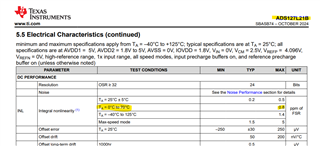Other Parts Discussed in Thread: ADS127L21B
Tool/software:
Hi,team
I would like to know how much INL varies based on 1LSB.
The LSB size of the ADS1219 is 244.14nV when using an internal VREF of 2.048V and a Gain of 1.
It says that the INL is a maximum of ±15ppm FSR.
In this case, there is an error of 15ppm of 2.048V, which means
2.048V x 15ppm = 2.048 x 0.000015 = 30.72uV
and I understand that there is a shift of 126LSB, but is this correct?
Also, if an external VREF is used, is it correct to use
External VREF x 15 ppm?
For example, if the external VREF is 4.5V, then 4.5V x 15ppm
Best Regards,
Koji



